As the entire world is busy combating the deadly coronavirus outbreak, a powerful solar storm is expected to hit the earth this week.
The stream of particles from the sun is now in its way to the earth, and calculations made by various space agencies reveal that it will hit the earth on April 4.
A third solar storm in seven days

It should be noted that earth was bombarded with a surge of solar particles on March 30 and March 31, and with this new arrival of fresh particles, it will be the third solar particle bombardment on the earth within seven days.
"Earth is exiting a stream of solar wind that sparked bright auroras around the Arctic Circle on March 30th and 31st. Some of the lights even dipped into the USA as far south as Michigan. The next stream of solar wind is due on April 4th," wrote weather forecasting site Space Weather.
As solar storms get bombarded in the magnetosphere of the earth, blue lights will appear as the atmospheric layer deflects the particles. However, experts believe that the impacts of the solar storm could be much more than the appearance of bright auroras.
What are the repercussions of a solar storm?
Experts believe that solar winds will heat the upper layer of the atmosphere, and this phenomenon will expand it. As solar storms approach the earth, it will affect the satellites in orbit. When satellite function gets disrupted, it will create negative impacts on GPS navigation, mobile phone signal, and satellite TV.
It should be also noted that solar storm bombardment will also result in high currents in the magnetosphere. This phenomenon will make higher electricity to flow in the power lines, and it may result in power station blowouts. Even though such a scenario has happened very rarely, experts have not ruled out such a possibility.









